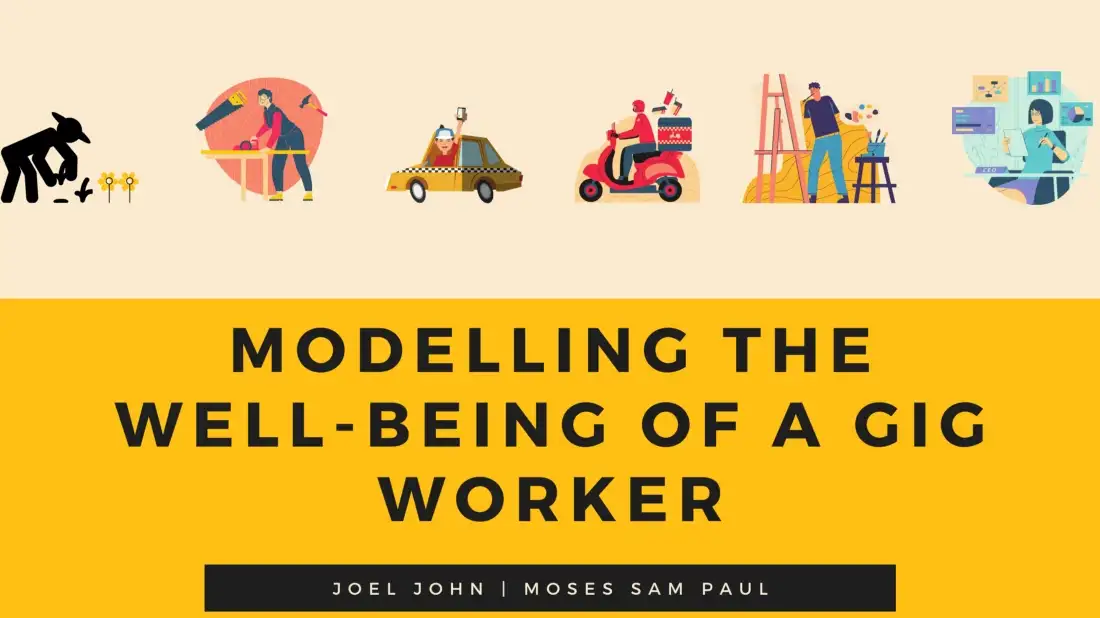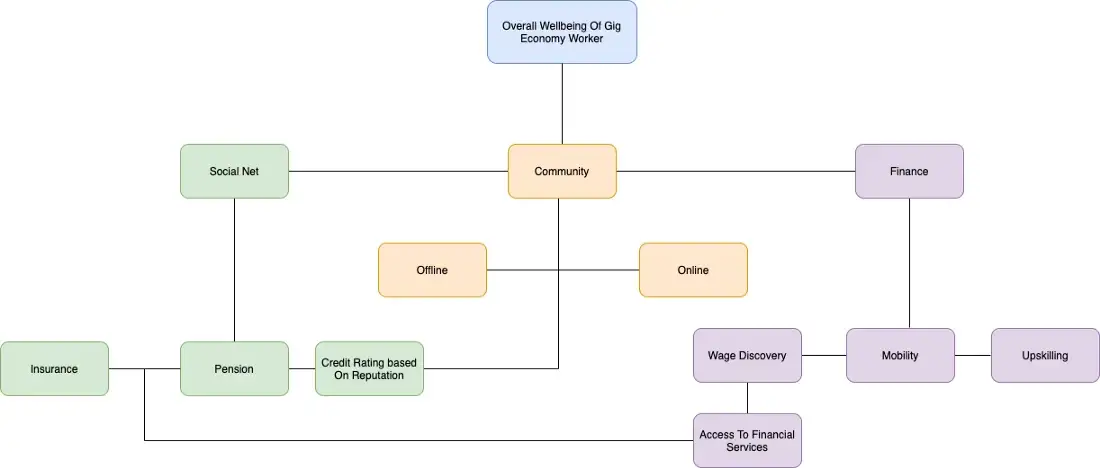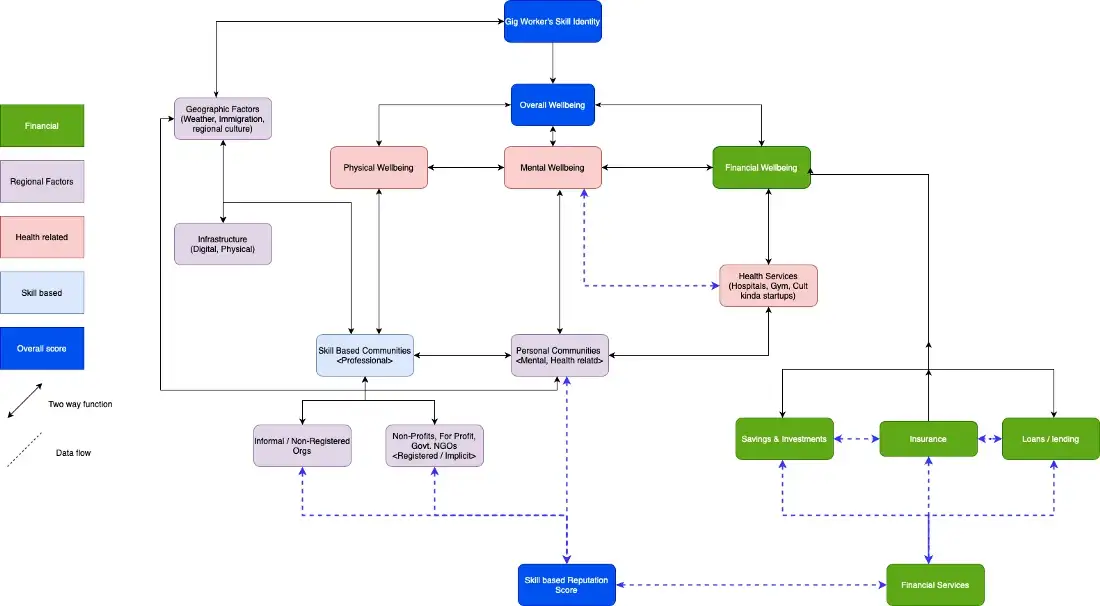
In discussing modern workplaces, we can come to the agreement that the ‘gig economy’ may be the future. However, neither its definition nor metrics for measuring a gig worker has been formalised globally, yet. The definition of a gig worker in India according to the Lok Sabha is ‘a person who performs work or participates in a work arrangement and earns from such activities outside of traditional employer-employee relationship(1)’. It goes on to categorise work into: crowd-driven work that is focused on a large number of individuals doing small-tasks (eg: Mechanical Turks), or on work-on-demand offerings such as those offered by platforms such as Swiggy and Urban Clap. The challenge here — is that it focuses on the nature of contract and employee-employer relationship instead of the skills they possess. This means that when we assess the gig economy — we may vastly miss out on individuals who hold multiple jobs, with varying nature of contracts and different skill-sets. This can be driven in favour of the gig worker with a unified platform for pre-verified skill identity. Some work may be seasonal, some could be on the basis of demand at a firm; while some could even be project oriented. The International Labor Organization recognises this and has now transitioned towards categorising gig economy under the umbrella of alternative workplace agreements.
Classifying Jobs In A Dynamic Environment
In order to provide a solution for the gig economy, as researchers we need to see things from their point of view. Individuals may be contract laborers that are engaged with a single firm or choosing to hold multiple, full-term employment — given the status of the economy today. A general classification of work alone will not help us create models that look at what contributes to a gig economy laborer’s productivity but it is where we began. The ISCO-08 classification (International Standard Classification of Occupations) for instance looks primarily at the nature of the job. They have it ranging from routine, menial work to managers and even army personnel. Closer to home in India, the classification is on basis of the tenure of the contract and number of parties in it. The problem again is the fact that the typical idea of having a single 9 to 5 job is slowly vanishing away with individuals having multiple “side-hustles”, part-time roles and jobs that help in paying the bill. Due to this, we concur that the way to classify work will be to look at the most basic abstraction of what makes work possible. That is skills. To study the classification of jobs, we considered the ISCO-08 model (2) (International Standard Classification of Occupations). However, we found it to be too restrictive in how work was defined at a time when alternative work agreements were becoming the trend. Germany’s work categorisation model from 2015 (3) has over 24,000 jobs mentioned, in a 5 tiered job classification system. We found it similar to the National Skill Development Corporation’s approach and have decided to opt for it due to its proximity to regional regulations. (4) The National Skill Development Corporation’s approach to categorising jobs breaks it down to give levels ranging across the sector, proficiency and sub-category of the industry a job is positioned in. This helps us get enough of an understanding of the seniority of the role and the level of skills it requires.
Evolution of our model
Naturally, skills on their own are not the sole constituents of what contributes to the overall well being of an individual. In order to explore the other factors, we had considered the financial well-being and social-net of the individual. Our assumption was that having a strong social-net would enable individuals to take on more risk, and access to financial services ensures the individual is able to save sufficiently. Our previous assumption failed to take into account the external factors that affect an employee’s productivity. These are matters that the individual cannot influence at the personal level but rather speak about as a community. One of the ways this manifests is in the form of internet access and public infrastructure: such as road connectivity can affect the likelihood of an individual being able to access a job. While these factors are not influenced directly by an individual at a large enough scale — democratic functions such as election of strong political leaders that ensure these public utilities are in place — is how a labourer ensures these matters are taken care of. We see institutions being instrumental in the new model. Similarly, the power of one’s passport can greatly affect the range of opportunities available to them. In order to account for this, our new model takes a look at the geographic functions of a region a worker is employed from.

The Base model failed to account for structural issues with the environment labor finds itself in
Additionally, we explored the specific constituents of each function and the role the community plays in it. We believe that any ideal model should aim to strike a balance between the markets and the state, with communities being the means through which the individual is able to influence both; by organising themselves as self-governing communities.
The revamped model also gives more weight to the health of an individual and breaks it down to physical and mental well-being. We consider the role a community plays in the mental well-being of an individual at the professional and personal level. In considering financial services in the model, health related data is taken into consideration on the basis of the fact that professional excellence is reliant on physical and psychological well-being. The new model explores how the flow of data will be with each of these components.
At the top, we have solely looked at what the functions of physical, mental and financial well-being are. As we go further lower, we see that communities that are registered (eg: non-profits, corporates and government bodies) and informal (eg: social clubs) feed into the opportunities and quality of a person’s professional life. As the transition goes lower, we see how data begins to emerge due to the model’s proximity to the application layer. This is where we see raw data emerging in terms of workplace reviews, financial transactions and health transcripts. Although the model does not go further, if we had to break it down — it diverges into skill-related applications and fintech applications that can be built on top of the collective score an individual has from this. However in order for that to occur, we need (i) transparency on how a model like this is computed (ii) clarity on where the data will be sourced from and (iii) how this data will be used.
To explore the same, we studied India’s data-privacy laws, China’s social credit system and the implementation of GDPR in Europe.

The Working Model: The new model explores community as the means through which a gig worker can optimise for his/her overall well-being by improving their bargaining power to negotiate better with the system (state & market).
Finding Strength Through Data Ownership
We observed that while we suggest taking a holistic view of an individual’s data to measure their well-being, we have not accounted for the fact that different data has different levels of sensitivity or availability. Financial data for instance can be readily accessed in a secure form through account aggregators but when it comes to healthcare data, even hospitals don’t share it with one another at a huge scale. This means our model will need to account for the difficulties in sourcing, analysing and storing varying data-forms of the individual. In doing so, it will need to align itself with the data privacy laws of the region, the task is undertaken at. We observed ownership and hence privacy of data is applicable at three layers:
1. at the level of the individual
2. of the market entities the individual engages with
3. the state
With a provision to include new institutions that might emerge such as co-operatives and communities and their role in data ownership and processing split-incentives.
At each of these layers the individual should hold the sovereign right to who gets to access their data. Lastly, when looked at from a systems dynamics model, the rate of change in the model will vary for different components. An individual’s social network can change within a matter of weeks by their ability to migrate but the institutions (such as immigration offices) that enable it take years to change and evolve. By focusing on the things that can change quicker, we hope to accelerate the pace at which other components evolve.
Our next step is to design the survey questionnaire that captures the various stock and flow variables of the above model, talk to more experts and gig workers at different skill levels (knowledge workers to private-property void farmland workers) to make sure the model captures the well being of a gig worker in its entirety. If you’re interested in the role of data ownership in the gig economy do reach out to us at research.theios@gmail.com.
References
Lok Sabha, Government of India. (2019). The Code on Social Security: 2019.
International Labour Organization. (2012). International Standard Classification of Occupations: Structure, group definitions and correspondence tables
Paulus, W., & Matthes, B. (2013). The German classification of occupations 2010: structure, coding and conversion table. FDZ-Methodenreport, 8, 2013.
Ministry of Labour & Employment, Government of India. (2016). National classification of Occupation — 2015
